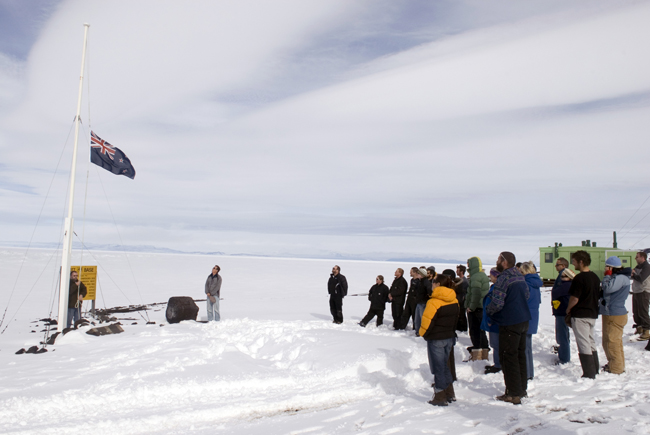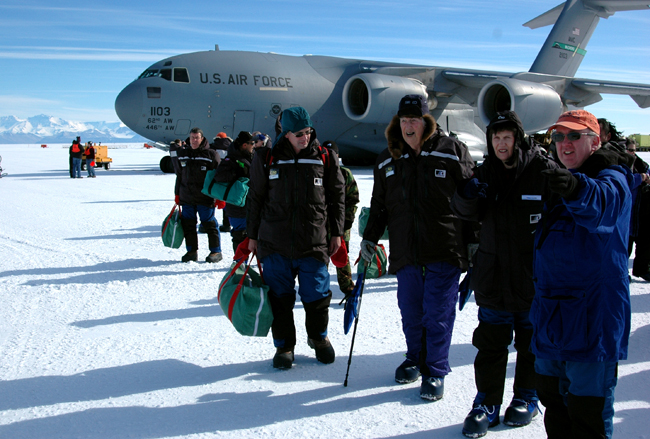
Photo Credit: Cpl. Nancy Cox |
New Zealanders from Scott Base lower their national flag during a brief memorial service on Jan. 11 (local time) for Sir Edmund Hillary, who died earlier that day in an Auckland hospital. |
Sir Ed passes away
Legendary explorer and mountaineer left mark on Antarctic history
By Peter Rejcek, Antarctic Sun Editor
Posted January 11, 2008
Sir Edmund Hillary, New Zealand’s favorite and most famous son, died Jan. 11 (local time) at the age of 88 in an Auckland hospital.
Hillary, more popularly referred to as Sir Ed, rose to fame in 1953 as the first man to summit Mount Everest, along with Sherpa Tenzing Norgay. But the former beekeeper also left his mark in the Antarctic, helping to establish New Zealand’s Scott Base on Ross Island in 1957 and leading the first overland vehicle traverse to the South Pole in 1958.
The residents at Scott Base, located near the U.S. Antarctic Program (USAP)’s McMurdo Station, held a brief memorial ceremony at 1 p.m. local time and lowered the New Zealand flag in his memory. The flag remained down until midnight Jan. 12. The base staff will lower the flag again on the day of his funeral, which had not been set at the time of this writing.
Hillary had returned to the continent last year to celebrate Scott Base’s 50th anniversary. He was also present in 2004 during the dedication of the Hillary Field Centre at Scott Base, a building to house and care for equipment used by scientists and staff in the field.
“I think we are very fortunate to have had this close relationship with Sir Ed,” said Yvonne Boesterling, Scott Base coordinator. “With the TAE hut, [Scott Base’s first building], just meters away from our flag pole, we have the option to refresh our memories of his accomplishments and his huge contribution to the NZ Antarctic Program.
“We are also lucky that there are several staff here who have had the opportunity to not only meet him, but to sit next to him in the dining hall at Scott Base or to accompany him out to the A Frame while he tells stories of his adventures,” Boesterling added. “Even those who have not met him know very much about him, as every New Zealander is closely connected to Antarctica and Scott Base in some way.”
Billy Wallace, Scott Base field training coordinator, wrote an ode to Hillary on the day of the famed mountaineer’s passing.
“Sir Ed will always represent to us what is quintessential Kiwi. Someone who saw what needed doing, and went out and did it,” Wallace wrote. “Someone who quietly yet confidently stepped beyond the comfort zone to get the job done.”

Photo Credit: Peter Rejcek
Sir Edmund Hillary arrives for his last visit to Antarctica in 2007.
Later in the piece, he said, “At present I am sitting in the new Hillary Field Centre at Scott Base. I am thankful that Sir Ed can finally rest. I am also pleased that Sir Ed was able to grace the folk of Scott Base last season. Many staff and scientists got to hear some classic Sir Ed stories straight from man himself – Scott Base will forever have the spirit of Sir Ed there to link the past with the present.”
Indeed, Hillary’s passing came nearly 50 years to the day of leading the first team to reach the South Pole by motorized transport – three small farm tractors. The crossing was not without its controversy, as Hillary was meant to play a supporting role to the leader of the Commonwealth Trans-Antarctic expedition, Sir Vivien Fuchs.
Instead, the intrepid Kiwi and his team slogged to the Pole, reaching it on Jan. 4, 1958 – despite official commands to the contrary.
Geoffrey Lee Martin, a journalist traveling with Hillary’s team and writing for newspapers in England and New Zealand, has documented the race to the Pole that wasn’t a race in the recently published book, “Hellbent for the Pole.” In an e-mail from Australia, Lee Martin forwarded a memoir to his friend that he wrote intended for several international papers after Hillary’s death.
Lee Martin said of the 1958 expedition: “Hillary told me later he ‘seemed to mislay some scraps of paper with messages on them.’ Quite typically, he also wrote testily in his memoirs: ‘If an explorer in the field always waited for permission from his committee back home, then nothing would get done, or it would be done too late.’”
Hillary’s death also came on the eve of the official dedication of the USAP’s new research station at the South Pole, a $153 million engineering marvel that supports a wide range of science activities at 90 degrees south.
A memorial service for Hillary was also scheduled at McMurdo Station on Jan. 13.
The chief executive officer of Antarctica New Zealand, Lou Sanson, said in a press release, “Ed was a towering legend in New Zealand’s identity with Antarctica. I was greatly privileged to accompany him to Antarctica on two separate occasions. … He was especially popular at Scott Base for sharing his life’s stories with others.”






